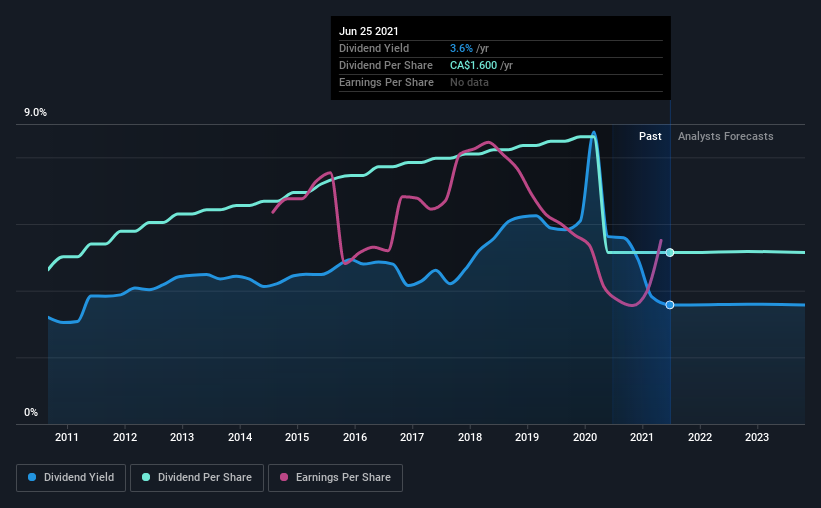Why You Might Be Interested In Laurentian Bank of Canada (TSE:LB) For Its Upcoming Dividend
Laurentian Bank of Canada (TSE:LB) stock is about to trade ex-dividend in 3 days. Typically, the ex-dividend date is one business day before the record date which is the date on which a company determines the shareholders eligible to receive a dividend. The ex-dividend date is an important date to be aware of as any purchase of the stock made on or after this date might mean a late settlement that doesn't show on the record date. Accordingly, Laurentian Bank of Canada investors that purchase the stock on or after the 30th of June will not receive the dividend, which will be paid on the 1st of August.
The company's next dividend payment will be CA$0.40 per share. Last year, in total, the company distributed CA$1.60 to shareholders. Looking at the last 12 months of distributions, Laurentian Bank of Canada has a trailing yield of approximately 3.6% on its current stock price of CA$44.78. If you buy this business for its dividend, you should have an idea of whether Laurentian Bank of Canada's dividend is reliable and sustainable. We need to see whether the dividend is covered by earnings and if it's growing.
Check out our latest analysis for Laurentian Bank of Canada
Dividends are typically paid out of company income, so if a company pays out more than it earned, its dividend is usually at a higher risk of being cut. That's why it's good to see Laurentian Bank of Canada paying out a modest 44% of its earnings.
Generally speaking, the lower a company's payout ratios, the more resilient its dividend usually is.
Click here to see the company's payout ratio, plus analyst estimates of its future dividends.
Have Earnings And Dividends Been Growing?
Companies with consistently growing earnings per share generally make the best dividend stocks, as they usually find it easier to grow dividends per share. If earnings fall far enough, the company could be forced to cut its dividend. With that in mind, we're encouraged by the steady growth at Laurentian Bank of Canada, with earnings per share up 2.7% on average over the last five years.
The main way most investors will assess a company's dividend prospects is by checking the historical rate of dividend growth. In the last 10 years, Laurentian Bank of Canada has lifted its dividend by approximately 1.1% a year on average.
The Bottom Line
Should investors buy Laurentian Bank of Canada for the upcoming dividend? Laurentian Bank of Canada has seen its earnings per share grow slowly in recent years, and the company reinvests more than half of its profits in the business, which generally bodes well for its future prospects. In summary, Laurentian Bank of Canada appears to have some promise as a dividend stock, and we'd suggest taking a closer look at it.
On that note, you'll want to research what risks Laurentian Bank of Canada is facing. In terms of investment risks, we've identified 2 warning signs with Laurentian Bank of Canada and understanding them should be part of your investment process.
A common investment mistake is buying the first interesting stock you see. Here you can find a list of promising dividend stocks with a greater than 2% yield and an upcoming dividend.
This article by Simply Wall St is general in nature. It does not constitute a recommendation to buy or sell any stock, and does not take account of your objectives, or your financial situation. We aim to bring you long-term focused analysis driven by fundamental data. Note that our analysis may not factor in the latest price-sensitive company announcements or qualitative material. Simply Wall St has no position in any stocks mentioned.
Have feedback on this article? Concerned about the content? Get in touch with us directly. Alternatively, email editorial-team (at) simplywallst.com.

 Yahoo Finance
Yahoo Finance 
